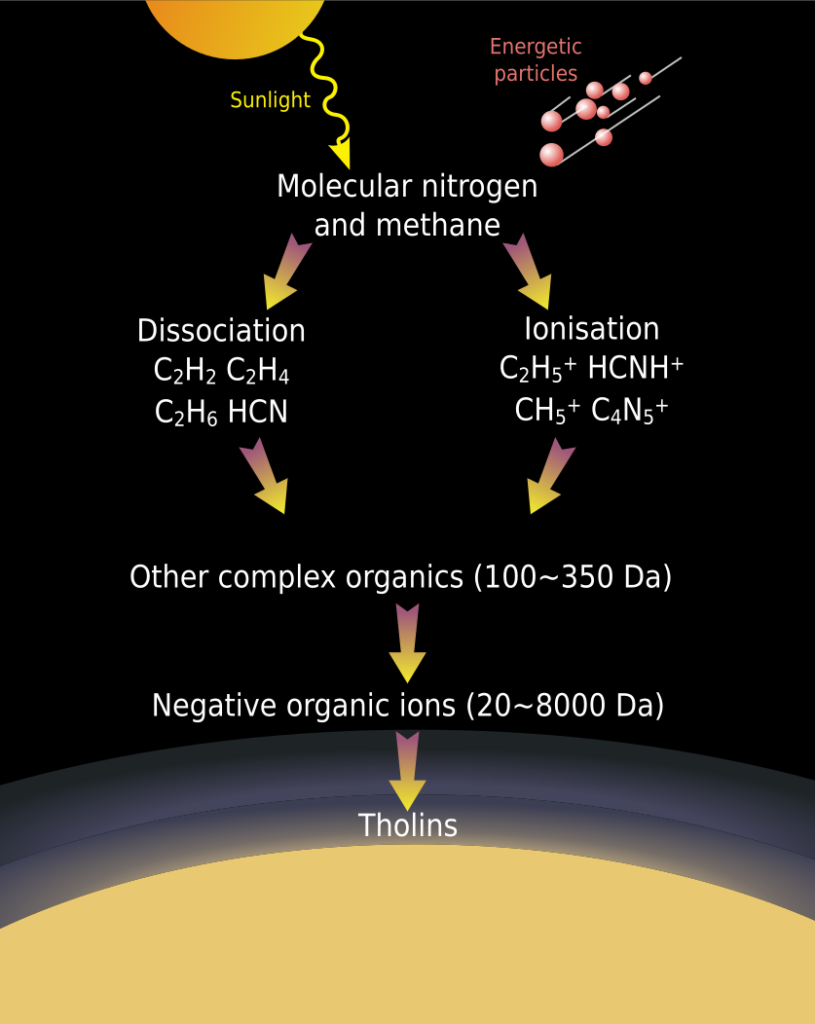Featuring image: Pluto is an icy object in the outer solar system. Its surface it not only covered by ice, but also by an unidentified red material. The largest of these red areas is the Cthulhu region in the southern hemisphere. NASA/JHUAPL/SwRI, public domain (CC0)
Paper: Testing tholins as analogues of the dark reddish material covering Pluto’s Cthulhu region
Authors: M. Fayolle, E. Quirico, B. Schmitt, L. Jovanovic, T. Gautier, N. Carrasco, W. Grundy, V. Vuitton, O. Poch, S. Protopapa, L. Young, D. Cruikshank, C. Dalle Ore, T. Bertrand, A. Stern
Pluto is an icy object beyond Neptune. Its surface is not only covered by innocent pale ice, but also by mysterious dark-red fields. What lurks in these hellish regions and where do they come from?
Far behind Neptune’s orbit, the icy body Pluto orbits our Sun. Pluto got a lot of attention in 2006, when it lost its status as a planet. Since then, it remained as a trans neptunian objects (TNO) of major interest. In 2015, Pluto presented itself in high resolution pictures for the first time in history, when NASA’s space probe New Horizons explored the outer regions of our solar system. What the pictures showed, was not the expected icy desert, but multiple areas of deep red all over Pluto’s surface. The largest of them is located on the southern hemisphere. As a homage to the master of subtle horror, H. P. Lovecraft, the area is called Cthulhu region, because some of the most mysterious and powerful beings in Lovecraft’s world originate from Pluto (in Lovecraft’s stories called Yuggoth). Fayolle and co-workers tried to better understand the origin of these red materials by using laboratory experiments and numerical modelling in comparison with the data recorded by the New Horizons space probe.

The spectral data from New Horizons indicate that the red regions are rich in complex organic molecules. Since its discovery in 2015, several theories emerged trying to explain the origin and composition of the red material. Until now, none of them was able to convince the astronomical community, but three are considered as the most plausible explanations. The first theory sets the origin of the organic, red material in connection to the formation history of Pluto. It is thought that Pluto was created by a collision of two smaller objects. The energy from the impact could have created a liquid and warm ocean on the surface. Experiments showed that complex organic compounds can be created in such an ocean. Following the second theory, the bombardment of high energy particles on Pluto’s surface could have triggered chemical reactions inside the surface ice. The composition of the ice is very complex and contains additional to water, nitrogen and carbon monoxide also methane and methanol. Lastly, according to the third theory the red material could reassemble dust agglomerates from photochemical reaction in the higher atmosphere of Pluto. At high altitudes, volatile gasses react with photons from the Sun and cosmic rays. The formed dust particles then sink down to the surface and clump together to tholins, which is the general term for complex organic agglomerates on planetary surfaces.
Could the red areas be regions where tholin was predominantly deposited? The new work from Fayolle and colleagues suggest that this could actually be the case. In laboratory experiments, the authors tried to recreate tholins of different compositions by irradiating gas mixtures, representative for the atmosphere over Pluto, with high doses of UV irradiation. A special emphasis of the study was to mimic the measurement conditions of the New Horizons data during the flyby. With a special optical system, they were able to simulate the geometry of the spectral analysis as it was used by the space probe. Furthermore, the results were used to create a numerical model to calculate theoretical spectra of Pluto’s complex ice surface, covered by tholin.
While the ice surface didn’t fit with the data from the space probe, the scientists observed a good fit when the effect of tholin was included into the model. Nevertheless, the spectra of the laboratory analogues were sensitive to the initial condition of the gas mixture and none of the experiments were in perfect agreement with the observations from Pluto. Nevertheless, the study added important evidence in favour for an atmospheric origin of the reddish material from the Cthulhu region. But further research is needed to unravel the hellish red mystery on Pluto’s surface.
License:
‘Call of Cthulhu — Can we uncover the secret of Pluto’s red spots?’ by Max Winkler is licensed under a Creative Commons Attribution-ShareAlike 4.0 International License.

